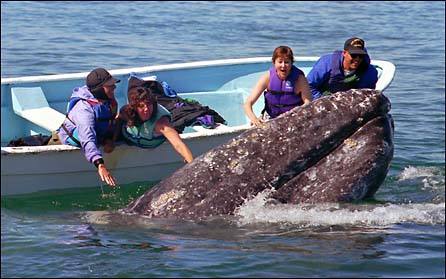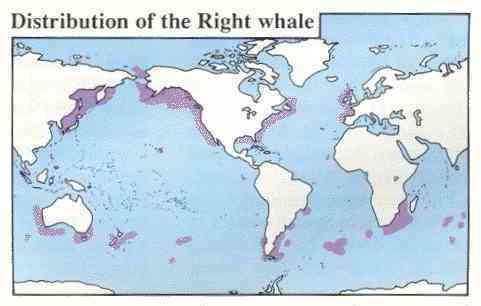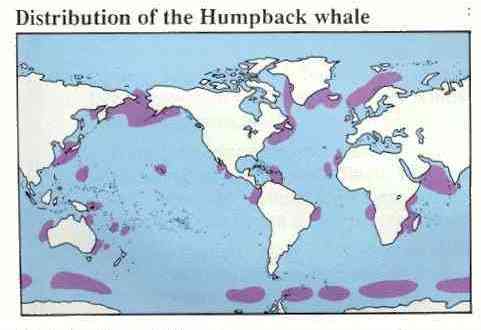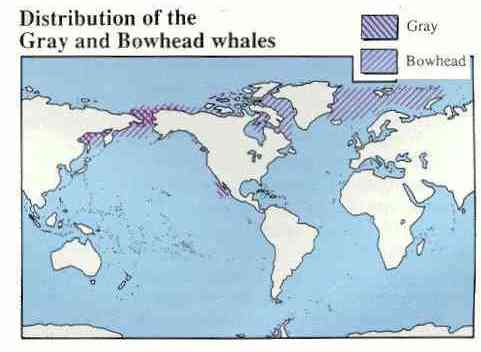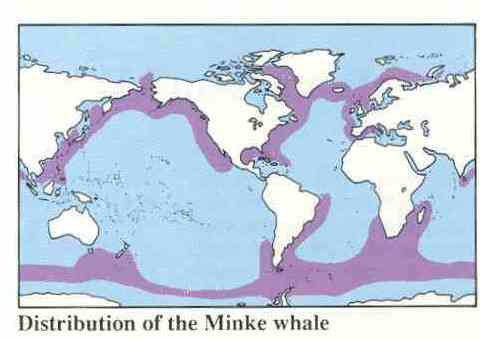Flukes of Nature
Saving the WailIt is from the progeny of this parent cell that we all take our looks; we still share genes around, and the resemblance of the enzymes of grasses to those of whales is in fact a family resemblance. - Lewis Thomas
Waltzing Matilda, Waltzing Matilda... Humpback whales, like Canadians, seem to have a hard time protecting their cultural traditions. Put a few rogue songsters in their midst and the whole population switches tune. In humpbacks, singing is done exclusively by males. It is clearly connected to mating. The animals sing on their way to and from their breeding grounds, and while they are loafing around there, but nobody is quite sure whether they do it to win the hearts of females or to warn off other males. Whatever the exact function, though, all the males of a given colony generally sing from the same song-sheet. And although tunes from different points in a given ocean basin are generally similar, those of populations separated by continents are unrelated. Whale songs do change over time, but until now all changes that have been heard have been gradual, and generated internally by particular groups. So imagine Michael Noad's surprise when he listened to the music produced by humpbacks off the east coast of Australia, and witnessed a revolution in musical taste. Dr Noad, who works at the University of Sydney, dropped hydrophones from buoys and small boats into the waters of the Great Barrier Reef while humpbacks were calving and mating there. Between 1995 and 1998 he and his team taped and analysed 1,057 hours of whale music-making. In the first two years, they heard two males singing a completely new and different song from that being chanted by the other 80. Then, in 1997, the upstart song began to gain popularity, with other males humming along. By the end of that year's southward migration along the reef, most of the east-coast whales had defected and swapped songs. By 1998, only the new song was heard. The researchers recognised that the new song was almost identical to one sung on the west coast of Australia in 1996. After 1996, the songs of the east and west coasts evolved separately, suggesting that the new tune was introduced by just a few interlopers from the west during a single season. The researchers say in this week's Nature that this is the first record of radical song change produced by such a small number of immigrants - at least since the Spice Girls visited Canada. Source: The Economist 2 December 2000
Daring Rescue of Whale off Farallons
One of the divers on the rescue team works on the crab pot lines that held the female humpback whale near the Farallon Islands. by Peter Fimrite A humpback whale freed by divers from a tangle of crab trap lines near the Farallon Islands nudged its rescuers and flapped around in what marine experts said was a rare and remarkable encounter. "It felt to me like it was thanking us, knowing that it was free and that we had helped it," James Moskito, one of the rescue divers, said Tuesday. "It stopped about a foot away from me, pushed me around a little bit and had some fun." Sunday's daring rescue was the first successful attempt on the West Coast to free an entangled humpback, said Shelbi Stoudt, stranding manager for the Marine Mammal Center in Marin County. The 45- to 50-foot female humpback, estimated to weigh 50 tons, was on the humpbacks' usual migratory route between the Northern California coast and Baja California when it became entangled in the nylon ropes that link crab pots. It was spotted by a crab fisherman at 8:30am. Sunday in the open water east of the Farallones, about 18 miles off the coast of San Francisco.
Moskito said about 20 crab-pot ropes, which are 240 feet long with weights every 60 feet, were wrapped around the animal. Rope was wrapped at least 4 times around the tail, the back and the left front flipper, and there was a line in the whale's mouth. The crab pot lines were cinched so tight, Moskito said, that the rope was digging into the animal's blubber and leaving visible cuts. At least 12 crab traps, weighing 90 pounds each, hung off the whale, the divers said. The combined weight was pulling the whale downward, forcing it to struggle mightily to keep its blow- hole out of the water. Moskito and three other divers spent about an hour cutting the ropes with a special curved knife. The whale floated passively in the water the whole time, he said, giving off a strange kind of vibration. "When I was cutting the line going through the mouth, its eye was there winking at me, watching me," Moskito said. "It was an epic moment of my life." When the whale realised it was free, it began swimming around in circles, according to the rescuers. Moskito said it swam to each diver, nuzzled him and then swam to the next one. "It seemed kind of affectionate, like a dog that's happy to see you," Moskito said. "I never felt threatened. It was an amazing, unbelievable experience." Humpback whales are known for their complex vocalizations that sound like singing and for their acrobatic breaching, an apparently playful activity in which they lift almost their entire bodies out of the water and splash down. Before 1900, an estimated 15,000 humpbacks lived in the North Pacific, but the population was severely reduced by commercial whaling. In the 20th century, their numbers dwindled to fewer than 1,000. An international ban on commercial whaling was instituted in 1964, but humpbacks are still endangered. Between 5,000 and 7,500 humpbacks are left in the world's oceans, and many of those survivors migrate through the Gulf of the Farallones National Marine Sanctuary. Whale experts say it's nice to think that the whale was thanking its rescuers, but nobody really knows what was on its mind. "You hate to anthropomorphise too much, but the whale was doing little dives and the guys were rubbing shoulders with it," Menigoz said. "I don't know for sure what it was thinking, but it's something that I will always remember. It was just too cool." Humpback whales hold a special place in the hearts of Bay Area residents ever since one that came to be known as Humphrey journeyed up the Sacramento River in 1985. The wayward creature swam into a slough in Rio Vista, attracting 10,000 people a day as whale experts tried desperately to turn it around. Humphrey went back to sea after 25 days of near-pandemonium and worldwide media attention. In the fall of 1990, Humphrey turned up again inside the bay in shallow water near the Bayshore Freeway, finally beaching on mud flats near Double Rock, just off the Candlestick parking lot. He remained stuck for 25 hours, until volunteers, helped by a 41-foot Coast Guard boat, pulled him free and sent him back to the ocean. He has not been seen since. Humpbacks like Humphrey do seem to relate to people more than other whales, according to Stoudt. "You do hear reports of friendly humpbacks, whales approaching boaters, especially in Baja California," Stoudt said, "but, for the most part, they don't like to be interacted with." Source: www.sfgate.com Page A - 1 14 December 2005 photo credit Marine Mammal Center via Associated Press
Worship the Whale
California gray whale encounter Laguna Ignacio, off the coast of Baja SIR, - Your editorial (December 1) is wrong. The whale is a deity, or deserves to be. It is the largest, gentlest, most beautiful creature on Earth. Is there a grander sight than the flukes of a whale rising clear of the water before plunging to the depths? To me, it is saying: "Admire me, love me, but let me get on with my life." If one must worship, why not worship a whale? The great poet W H Auden, after visiting the hell-hole of a whaling station in Norway and watching men cut up a newly killed whale, still steaming, had this to say: "It gave one extraordinary vision of the cold ferocity of the human species." It's enough to make you wince and want to hide. Alistair Campbell Source: The Dominion Friday 8 December 2000 photo credit Dennis Poroy Associated Press
Introduction
Baby Beluga
Visitors watch a beluga whale at the Hakkeijima Sea Paradise amusement park in Yokohama, Japan, on 29 April 2005.
Slaughtered Whales 200 Years OldResearch results announced yesterday on the longevity of bowhead whales cast doubt on claims made by indigenous whalers that they are slaughtering the species at a sustainable rate, conservationists say. Indigenous whaling leader Canadian Tom Happynook told the World Council of Whalers conference in Nelson this week that if whale hunting was sustainable, there is no reason why indigenous peoples in coastal communities should not economically benefit from the resources. But scientists said yesterday the bowhead whales being hunted by indigenous communities in the Arctic may be the oldest mammals on earth, with some more than 200 years old when killed. New Scientist magazine reported Kerry Finley, an independent biologist who has studied bowhead behaviour for 14 summers in the Canadian Arctic, said the surprising longevity of bowheads suggested that even without interference the population would grow extremely slowly. This meant decisions by authorities to allow their slaughter by hunters looked misguided. "To play statistical brinkmanship with such odds is irresponsible. The consequences won't be known for a long time." An Auckland-based anti-whaling campaigner, Sarah Duthie, of Greenpeace, said the whales' long life and slow breeding suggested Arctic indigenous communities claiming to be slaughtering whales "sustainably" were only guessing. The latest research raised real questions over scientific basis on which indigenous communities around the Arctic could claim their whale kill was at sustainable levels, she said. The United States permits the killing of some 60 bowhead whales each year by Native Americans in Alaska for "cultural reasons" even though bowhead whales are on the World Conservation Union red list. But this week's New Scientist reported that it was impossible to say whether the kill of bowhead whales in Arctic waters was sustainable - adequate data was simply not available. Craig George, lead scientist with Alaska's North Slope Borough Department of Wildlife Management, said the age of the whales came to light only after hunters from the 6000 Inupiat Eskimos who live along Alaska's northern edge found stone-age harpoon heads inside bowheads they were butchering. Dr George noted the whales that survived those old attacks were probably already mature when they were first harpooned, which would make bowheads among the most long-lived animals on Earth. - NZPA Source: The Evening Post Saturday 18 November 2000
One whale was discovered to be 211 years old at the time of its death. That whale, alive during the term of President Clinton, was also gliding slowly and gracefully through the Bering, Chukchi and Beaufort seas when Thomas Jefferson was president... Bowheads are an endangered species and there are currently about 8,000 to 12,000 left. They travel in small pods and calves weigh as much as six tons at birth. Their only foes are man and orca whales. Alaskan whalers find the harpoon fragments as they carve the 50-foot long whales up with chainsaws after using powerful 21st century guns to kill them. Whaling has always been a prominent source of food for Alaska Eskimos, and is monitored by the International Whaling Commission. A hunting quota for Alaska Eskimo whalers was recently renewed, allowing 255 whales to be harvested by 10 villages over five years. Perhaps it is time to give this practice up?
IWC Rejects Japan's Bid to Resume Commercial WhalingBerlin - Anti-whaling nations blocked Japanese requests Wednesday to resume commercial whaling, calling for more research into stocks before any easing of a 17-year international ban. A global whaling conference voted 27-17 and 26-19 to defeat two Japanese motions - one seeking permission to take from the North Pacific 150 Bryde's whales a year between 2004 and 2008, and another for 150 minke whales starting this year. "The science is not complete yet," said US delegate Michael Tillman, whose country lined up with nations including Britain, Australia and Korea to defeat the proposal. The votes at the International Whaling Commission's annual meeting were a fresh rejection for pro-whaling forces such as Japan, Norway and several Caribbean nations after the majority voted Monday to strengthen whale conservation efforts. But Iceland defended its tentative plan to kill whales for scientific research, as it is entitled to do under IWC rules - a path already taken by Japan. Pro-whaling countries say conservationist concerns have obscured the commission's purpose to work out quotas for whaling that would allow sustainable hunting. Japan argued that going ahead next year would provide a working example for a system to monitor catches that could end the squabbling. "We're seriously concerned because the discussions seem to be limitless," Japanese delegate Masayuki Komatsu said. "International observers would be welcome." Backed by Norway and Iceland, Japan said it also needed to resume whale hunting to help traditional fishing communities. The defeat came during a bad-tempered third conference day dominated by calls for further research into whale populations before lifting the 1986 moratorium. Anti-whaling countries argue that too little is known about whale stocks, pointing out that they are also threatened by accidental capture by fishing vessels. "It's very urgent to take action in this field," said Peter Bradhering, head of the German delegation. "It's a global challenge." The group voted Monday to set up a committee within the 50-nation IWC to work with wildlife groups in bolstering protection efforts. But anti-whaling nations failed Tuesday in their latest attempt to set up two new ocean sanctuaries for whales. Japanese kill hundreds of whales annually under an exemption for limited "research" hunts. The government says the hunts help gauge the impact of whale herds on fisheries stocks and provide data on their migration patterns and population trends. Critics call the program commercial whaling in disguise because the meat is sold later to wholesalers and ends up in Japanese restaurants. Source: www.japantoday.com Thursday 19 June 2003 from wire reports
Prime Minister Condemns Fleet SailingHe piled upon the whale's white hump the sum of all the general rage and hate felt by his whole race from Adam down; - Herman Melville Whaling Conference - Prime Minister Helen Clark yesterday condemned the sailing of the Japanese whaling fleet, and said it planned to kill up to 440 minke whales. She said she was "outraged that Japan continues to practice such a barbaric hunt." It was thinly-disguised excuse to obtain whale meat to be eaten by wealthy Japanese. Greenpeace yesterday said the Japanese fleet set sail yesterday for the waters of the Southern Ocean whale sanctuary for the 2000-2001 hunting season. Greenpeace called for the Government to bar Japan's whaling fleet from New Zealand ports, except in case of an emergency. By resuming the hunting around Antarctica, Japan was breaking its international commitments under the United Nations Convention on Law of the Sea (UNCLOS), the environmental lobby group said. It had asked the Japanese Government to overrule its national Fisheries Agency sponsoring the hunt. - NZPA Source: The Evening Post Saturday 18 November 2000
Whales Lose, Japan Wins at ConferenceWhales emerged the big losers as a weeklong International Whaling Commission meeting wrapped up in Chile on Friday, said conservation groups, dismayed that anti-whaling nations were unable to halt number one hunter Japan. Anti-whale hunting nations spearheaded by Australia voiced deep concern at Japan's skirting of a 1986 moratorium on commercial whaling by hunting hundreds of whales each year in the name of scientific research. The divide between the two sides has generated so much tension that IWC chairman Bill Hogarth set up a working group to gain a year-long breathing space to try to build consensus and avoid confrontation this year. But the deliberate nonconfrontational tack, with nations urged not to vote against each other on contentious issues like Japanese whaling or calls for a South Atlantic whale sanctuary, meant little was achieved at the meeting. "I think it was a disappointing week for whales," said Ralf Sonntag of the International Fund for Animal Welfare. "Japan goes home without any votes or resolutions against it. Iceland started a new round of commercial whaling just prior to this conference. So they are not taking it very seriously. Nothing has been achieved for the whales," Sonntag said. Japan has given itself a special permit to catch 1000 whales each year despite the moratorium, while Norway and Iceland continue to hunt whales in defiance of the nonbinding ban. Aboriginals in Greenland, Russia and Alaska are granted special concessions to continue catching whales for subsistence purposes. But conservation groups were heartened that anti-whaling nations blocked a bid by Greenland to raise its hunt quota by another 10 humpback whales this year, amid claims some whale meat is being sold commercially in Greenland supermarkets. "The real risk of this week was that it would be business as usual at the end of the meeting, and to a certain extent that is true," said Mick McIntyre, director of conservation group Whales Alive. "The whaling countries still have unregulated so-called scientific whaling which they will continue to expand at their pleasure," McIntyre said. Australia, which deeply opposes whaling and has proposed reforms like joint nonlethal whale research with Japan and conservation management, put a brave face on the meeting's outcome. "We would count it as having been in the main a constructive and positive engagement," said Australian Environment Minister Peter Garrett. "We're opposed to commercial whaling, we think the moratorium should stay in place and we're opposed to so-called scientific whaling in the way it is being conducted by Japan," he said. "There are significant potential activities that countries can engage in in terms of cetacean research and whale use which doesn't require whales to be killed," he added, referring to a burgeoning global whale-watching industry. Source: stuff.co.nz 28 June 2008
Points NotedAs a Japanese visitor to your most beautiful country, I have been dismayed by the failure of New Zealanders to understand the sublime beauty of the Japanese philosophy on humane culling of whales for scientific research and eating. One day the world will thank Japan for the many benefits to mankind this research will bring. Not the least of these will be a warmer understanding, through dismemberment, of the delicate relationship between ocean-going mammals and human beings. It will bring, too, development of an exquisite culinary art through which vast fleshy objects may be transformed into delicious bite-size finger-food for diplomatic parties. Miso Tofu Source: Opinion page article "'Points Noted': The Ultimate Deflation" by Alex Veysey printed in The Evening Post 10 August 2000 See also:
Source: WWF Atlas of the Environment 1990
Source: iwcoffice.org last updated 30 May 2007
The Politics of WhalingTokyo - The Japanese to expand their research on w85les A visit to Kujiraya, the only restaurant in Tokyo that specialises in the cuisine of whales, has become a rite of passage for foreign journalists in Japan. There, for the benefit of their readers, they bravely get stuck into the dishes on offer: sizzling whale steaks, delicate sashimi (sliced raw meat) and rich, marbled ono-mi, the prized, fatty meat from the tail. Japan’s whaling programme, their articles claim, flouts the will of the world; its scientific research on these wise and noble creatures is a camouflage for a scheme to keep its whaling industry going until a moratorium on commercial whaling is lifted. These claims are sympathetically received abroad. Norman Mineta, the American commerce secretary, wrote in the Washington Post recently that it was time for Japan to allow whales to recover after decades of killing. In protest at Japan’s decision this year to expand its research programme, America has boycotted two environmental meetings that Japan has been holding this week. It will oppose Japan’s bid to play host to next year’s meeting of the International Whaling Commission (IWC), which was set up in 1946 to conserve whale stocks and so promote sustainable commercial whaling. America may also punish Japan with trade sanctions. What is the truth about Japanese whaling? The government’s stout defence of the Japanese tradition of eating whalemeat appeals to prickly nationalists, although in fact the custom spread only after the second world war, when other sources of protein were scarce. But, propaganda aside, the government clearly also feels it is being treated shoddily. It is western governments, it says, not the Japanese, that flout the international convention that governs and, in certain circumstances, allows whaling. Every year since 1987, the 9 vessels belonging to Kyodo Senpaku, a private fishing company, have hunted and killed several hundred Minke whales. Before the IWC’s moratorium took effect in 1986, Kyodo Senpaku was called Nippon Kyodo Hogei. This firm was formed from the consolidation of the whaling operations of several big Japanese fishing companies as the industry shrank during the 1970s. The main source of Kyodo Senpaku’s $45m of annual revenues is fees paid by the Institute of Cetacean Research, a foundation formed in 1987 which took over the research activities, along with a $10m grant, of the Japan Whaling Association, a trade body. The thrust of this research, say government officials, is to determine the characteristics of Minke whale stocks in preparation for the resumption of controlled, sustainable, commercial whaling. This, they maintain, is best done using samples that can be collected only by killing whales. Each year, the research institute sells 2,000-3,000 tonnes of whalemeat to the Japanese government, thereby paying for most of the cost of the research. The government sets the price, depending on the cut: ¥3,000 - 4,000 per kilo ($13 - 17 per pound) for the red meat, comparable in price to top-quality tuna or Kobe beef; ¥5,000 - 6,000 for the tail meat. Most of this meat is then distributed to Japan’s prefectural governments. The only prefecture that declines to buy whalemeat is the island of Okinawa. Okinawans prefer to eat dolphins.* These local governments distribute the whalemeat to wholesale fish markets. From there, via fish wholesalers, it ends up in department stores, sushi bars and restaurants. One fifth of the whalemeat bought from the institute is kept by the central government for, among other things, promoting the consumption of whalemeat. Anti-whaling countries see the close relationship between the government, the research institute, the trade association and the fishing company as evidence that the purpose of Japan’s research programme is in fact to sustain its commercial whaling industry — that is, Kyodo Senpaku and its 300 employees. In Japanese eyes, however, this sort of government - business relationship is the rule, not the exception. Anti-whaling countries claim the annual catch is far in excess of what is needed for scientific purposes, and point to the fact that “researched” whales end up on Japanese dinner plates. The Japanese say they are only abiding by the IWC’s governing convention, which requires that whales killed for scientific purposes shall, so far as practicable, be processed. Greg Donovan, editor of the IWC’s research journal, says that scientific opinion about the legitimacy of Japan’s research programme is split, although there is agreement that it has led to a “substantial improvement in knowledge”. It is their frustration over the work of the committee that irritates the Japanese. IWC scientists have determined that, in certain waters, Minke, Fin, Gray and Bryde’s whales are now abundant enough to be hunted commercially. They have also devised a way of calculating catch limits. At first, the IWC’s politically appointed commissioners refused to adopt this work, prompting the resignation of the scientific committee’s British chairman, Philip Hammond, in 1993. Since then, talks have got bogged down over various non-scientific issues, such as whether all whaling ships should be forced to accept international observers. Some countries, among them Australia and New Zealand, have said that they will oppose the resumption of commercial whaling on any grounds, a position Japan says conflicts with the IWC’s rules. The United States has never taken that line, says Rolland Schmitten, America’s commissioner to the IWC. America is upset because Japan is expanding a whaling programme which America claims is already excessive and unnecessary. In general, says Mr Schmitten, the majority of scientists on the scientific committee do not support the new programme. Mr Donovan merely speaks of “considerable disagreement”. Mr Schmitten says that there was a real advance at the IWC this year towards a resumption of commercial whaling. He is therefore puzzled at the timing of a provocative new research programme by Japan. Whatever the truth about Japan’s motives, however, it is hard not to sympathise with its broader frustrations with IWC politics. Perhaps Japan is in breach of the spirit, if not the letter, of the 1946 convention. But it is clear that countries such as Australia are in breach of both. If some whales have become abundant enough to be hunted, says Japan, no one has a right to tell the Japanese that they cannot catch and eat them. Source: The Economist 9 September 2000 © 1995-2000 The Economist Newspaper Group Limited all rights reserved
*-------- Original Message -------- This message was posted via the Feedback form. Comments: I was just wondering where you've gotten your information about Okinawan people in Japan "prefering to eat dolphin meat" over whale meat. I'm from the islands, and I can tell you I've never seen or eaten dolphin meat in Okinawa nor have I heard of anyone ever consuming it (the only time I've ever heard of it was from a "Japanese mainlander" living in Wellington New Zealand) - not in the past 50 years or so at least. My grandparents who are Okinawans and lived to be 96 years old (have since passed away), have never eaten dolphin meat as well. However, they've mentioned dolphins were caught in the fishing nets sometimes. Okinawans DO NOT PREFER DOLPHIN MEAT OVER WHALE MEAT. I'd like to know where you got your information, and if it is correct, where does one buy the meat, or what restaurant serves this dish? Okinawa is a beautiful Island, we worship the sea, if you are correct, I am ashamed and embarrassed for our people and maybe there's something I can say or do? We follow a different historical path from the "Mainland Japanese" people. Our diet is very different from them as well.
My apologies to Mr Wells. The Economist is generally a reliable source. Certainly no offense to Okinawa was meant. As to the Japanese - I happen to think that its fairly easy not to sympathise with their frustrations. But, then, I'm a vegetarian anyway. If human meat became the rage, I feel certain Japan wouldn't feel that no one had a right to tell them they couldn't eat the crew of boats they were able to catch.
For more on animals, including reptiles, crustaceans, arachnids, insects, fish, birds, pets, livestock, rodents, bears, primates, whales and Wellington's waterfront, click "Up"
below to take you to the Table of Contents for this Animals section. |
 Animals
Animals Animation
Animation Art of Playing Cards
Art of Playing Cards Drugs
Drugs Education
Education Environment
Environment Flying
Flying History
History Humour
Humour Immigration
Immigration Info/Tech
Info/Tech Intellectual/Entertaining
Intellectual/Entertaining Lifestyles
Lifestyles Men
Men Money/Politics/Law
Money/Politics/Law New Jersey
New Jersey Odds and Oddities
Odds and Oddities Older & Under
Older & Under Photography
Photography Prisons
Prisons Relationships
Relationships Science
Science Social/Cultural
Social/Cultural Terrorism
Terrorism Wellington
Wellington Working
Working Zero Return Investment
Zero Return Investment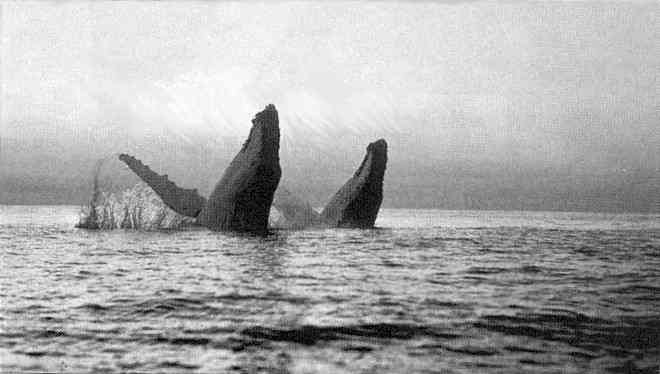
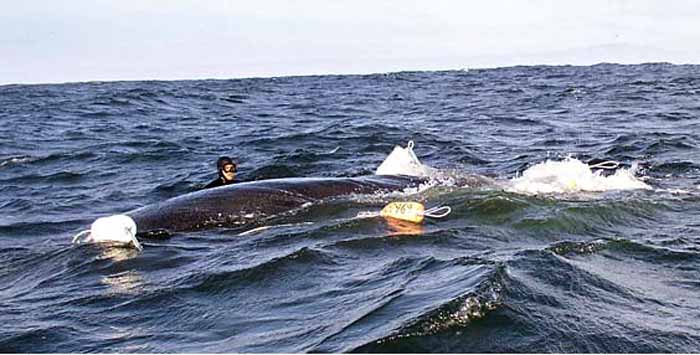
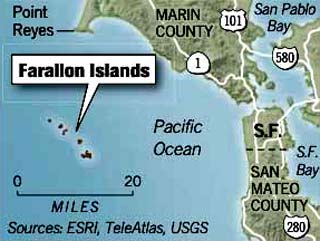 Mick Menigoz of Novato, who organises whale watching and shark diving expeditions on his boat the New
Superfish, got a call for help Sunday morning, alerted the Marine Mammal Center and gathered a team of divers. By 2:30pm, the rescuers had reached the whale and evaluated the
situation. Team members realised the only way to save the endangered leviathan was to dive into the water and cut the ropes. It was a very risky maneuver, Stoudt said, because the mere
flip of a humpback's massive tail can kill a man. "I was the first diver in the water, and my heart sank when I saw all the lines wrapped around it," said Moskito, a 40-year-old Pleasanton
resident who works with Great White Adventures, a cage-diving outfit that contracts with Menigoz. "I really didn't think we were going to be able to save it."
Mick Menigoz of Novato, who organises whale watching and shark diving expeditions on his boat the New
Superfish, got a call for help Sunday morning, alerted the Marine Mammal Center and gathered a team of divers. By 2:30pm, the rescuers had reached the whale and evaluated the
situation. Team members realised the only way to save the endangered leviathan was to dive into the water and cut the ropes. It was a very risky maneuver, Stoudt said, because the mere
flip of a humpback's massive tail can kill a man. "I was the first diver in the water, and my heart sank when I saw all the lines wrapped around it," said Moskito, a 40-year-old Pleasanton
resident who works with Great White Adventures, a cage-diving outfit that contracts with Menigoz. "I really didn't think we were going to be able to save it."